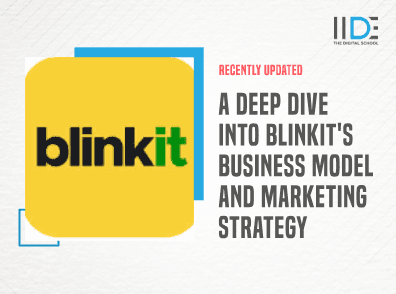Join an online Q&A session with the Director of Student Success to explore what your experience as an IIDE student will be like. Register Now.

Updated on Dec 11, 2025
Share on:
Blinkit's business model is built on rapid delivery, an extensive dark store network, and seamless customer experience. This strategy allows them to offer groceries within minutes while maintaining competitiveness in quick commerce. Blinkit achieves this by expanding its infrastructure, leveraging technology, and integrating with Eternal.
It uses automation and data analytics to streamline operations. But what's the secret behind Blinkit's market dominance? Its aggressive expansion and strategic partnerships drive rapid growth and customer loyalty. Want to know how? Keep reading to decode Blinkit's success!
About Blinkit
Founded in December 2013 by Albinder Dhindsa and Saurabh Kumar as Grofers, Blinkit rebranded in December 2021 to focus on quick-commerce delivery. Acquired by Eternal Limited (formerly Zomato) in August 2022 for $568 million, Blinkit has rapidly expanded its presence across India.
As of June 2025, Blinkit operated over 1,500 dark stores across more than 30 cities, delivering groceries and essentials within minutes. In Q1 FY26, Blinkit reported a revenue of ₹2,400 crore, a 156% year-on-year growth, with a Gross Order Value (GOV) of ₹11,821 crore.
The company's ethos revolves around customer-centricity, speed, and innovation. Blinkit prioritises fast delivery, user-friendly technology, and a wide product assortment to enhance customer satisfaction.
Blinkit's secret to success lies in its aggressive expansion strategy, leveraging technology for operational efficiency, and integrating services with its parent company to offer a seamless customer experience.
Summary Table:
| Feature | Details |
|---|---|
| Founded | December 2013 |
| Founder | Albinder Dhindsa, Saurabh Kumar |
| Headquarters | Gurgaon, Haryana, India |
| Industry | Quick-Commerce (Q-Commerce) |
| Revenue (FY25) | ₹2,400 crore |
| Presence | Over 1,500 dark stores across 30+ cities |
| Employees | Estimated 10,000+ |
| Popular For | 10-minute grocery and essentials delivery |


Learn Digital Marketing for FREE


How does Blinkit make money?
Revenue Stream Breakdown:
- Product Sales: Revenue generated from the sale of groceries and essentials, including perishable items, snacks, beverages, and more.
- Subscription Fees: Income from Blinkit Plus membership, which offers benefits like free deliveries and exclusive offers.
- Advertising Revenue: Earnings from brands advertising on Blinkit's platform, reaching a targeted consumer base.
- Services: Revenue from premium services such as express delivery, premium packaging, and other value-added offerings.
Revenue Contribution:
- Product Sales: Product sales account for approximately 70% of Blinkit's total revenue, driven by high-frequency grocery purchases.
- Subscription Fees: Around 10% of revenue comes from Blinkit Plus memberships, which encourage repeat usage.
- Advertising Revenue: Blinkit earns about 15% from advertising, benefiting from a large user base and targeted marketing.
- Services: 5% of revenue comes from value-added services, including express delivery and premium packaging, which enhance customer experience.
Pricing Strategy:
Blinkit employs a value-based pricing strategy, offering competitive prices for fast and convenient grocery delivery.
This pricing model attracts a broad customer base, balancing affordability with quick delivery services.
By offering cost-effective pricing alongside convenience, Blinkit captures both price-sensitive and time-sensitive customers, solidifying its position in the competitive quick-commerce space.
Blinkit Business Model Canvas

Blinkit Value Proposition
Blinkit offers unparalleled convenience by delivering groceries and essentials within 10 minutes. This rapid delivery service meets the needs of busy urban consumers seeking quick access to daily necessities.
Blinkit’s value proposition is based on offering unparalleled convenience by delivering groceries and essentials within 10 minutes, addressing the increasing need for speed and convenience in urban areas. Unlike traditional grocery stores, Blinkit combines fast service with a wide product assortment, providing customers with a user-friendly app for seamless ordering.
Customer Needs Solved: Blinkit caters to busy, tech-savvy consumers who value affordability and speed. The platform allows customers to quickly access daily necessities, solving the pain point of waiting in long queues or driving to stores.
Emotional Benefits: Blinkit provides peace of mind by delivering exactly what the customer needs in record time, fostering a sense of reliability and convenience.
Functional Benefits: The company saves customers time and effort through rapid delivery and seamless user experience, making it easy to order products with minimal effort.
Competitive Advantage: Blinkit’s deep integration of dark stores and optimised logistics gives it a significant edge, enabling fast and reliable deliveries that are hard to replicate.
Blinkit Revenue Model
Blinkit earns primarily through product sales, contributing 70% of total revenue.
Subscriptions, including Blinkit Plus memberships, generate 10% of revenue by offering benefits like free delivery.
Advertising revenue from in-app promotions accounts for 15%, while delivery services and other value-added services contribute 5%.
Blinkit’s revenue model leverages its quick commerce model to deliver convenience, and its diversified streams ensure long-term growth and stability.
Blinkit Cost Structure
Blinkit’s major expenses include logistics, technology development, marketing, and warehousing.
To optimize costs, Blinkit focuses on automation in its dark stores and delivery processes, while also leveraging economies of scale.
By investing in advanced technologies, Blinkit keeps operational costs in check, while its supply chain optimization ensures a more efficient, cost-effective model.
Despite rising expenses, Blinkit maintains healthy margins due to its competitive pricing and efficient operations.
Blinkit Customer Segment
Blinkit targets urban consumers, particularly those aged 18-45, including working professionals and tech-savvy individuals.
The brand operates on a B2C model, catering to customers seeking affordable, quick solutions for daily needs.
Blinkit’s appeal is further extended to value-seeking customers in semi-urban areas, with a strong focus on providing speed and convenience.
The platform particularly resonates with customers who prioritise fast delivery and seamless shopping experiences.
Blinkit Distribution Channels
Blinkit operates primarily through its mobile app and website, providing a digital-first experience for customers.
While the platform operates through third-party delivery apps for a broader reach, it follows an omnichannel strategy, integrating both physical and digital touchpoints.
The company’s dark store network enables rapid delivery, and its in-app ordering streamlines the customer journey, providing a convenient and fast shopping experience.
Automated checkout and contactless ordering further enhance customer convenience.
Blinkit Key Partnerships
Blinkit’s key partnerships include suppliers for a diverse range of grocery and essential products, logistics providers for last-mile delivery, and technology partners for developing its app and AI-powered features.
The brand also collaborates with third-party delivery platforms for extended reach and faster service.
Blinkit’s strategic partnerships with sustainability-focused organisations ensure it meets environmental goals, focusing on eco-friendly packaging and responsible sourcing to align with customer expectations for sustainability.
Want to Know Why 5,00,000+ Students Trust Us?
Dive into the numbers that make us the #1 choice for career success

MBA - Level
Best For
Fresh Graduates
Mode of Learning
On Campus (Mumbai & Delhi)
Starts from
Jan 5, 2026
Duration
11 Months
Live & Online
Best For
Working Professionals
Mode of Learning
Online
Starts from
Jan 5, 2026
Duration
4-6 Months

Online
Best For
AI Enthusiasts
Mode of Learning
Online
Duration
5 Months

Offline
Best For
12th Passouts
Mode of Learning
On Campus (Mumbai)
Duration
3 Years
Recent Post
Digital Marketing Courses Nearby
You May Also Like
The BlinkIt business model revolves around revenue from warehousing fees, advertising, and customer charges. It relies on dark stores for rapid delivery, aiming to fulfill orders within 15-20 minutes and maintains profitability through a high average order value.
BlinkIt generates revenue through three main channels: warehousing services and marketplace commissions, advertising fees, and customer charges for delivery and handling. This diverse revenue stream supports its rapid delivery and high profitability.
Dark stores are mini-warehouses located close to customers, allowing BlinkIt to deliver orders within 15-20 minutes. These stores, stocked with a wide range of products, enhance operational efficiency and contribute significantly to BlinkIt’s competitive edge.
BlinkIt manages costs through strategic spending on last-mile delivery, dark store operations, and other variable costs like packaging. Customer acquisition costs are also carefully managed through targeted promotions and discounts to attract new users.
BlinkIt’s high average order value (AOV) is crucial as it increases profitability per delivery. By offering a broad product range, including high-value items, BlinkIt boosts its AOV, which significantly enhances its overall financial performance.
BlinkIt’s business model stands out due to its extensive use of dark stores, high average order value, and rapid delivery times. Compared to competitors, BlinkIt’s approach provides a faster service and a broader product range, giving it a competitive advantage.
Advertising is a key revenue source for BlinkIt, with brands paying for prominent product placements within the app. This advertising revenue helps BlinkIt fund its operations and enhances its visibility, further driving customer engagement and sales.
Aditya Shastri leads the Business Development segment at IIDE and is a seasoned Content Marketing expert. With over a decade of experience, Aditya has trained more than 20,000 students and professionals in digital marketing, collaborating with prestigious institutions and corporations such as Jet Airways, Godrej Professionals, Pfizer, Mahindra Group, Publicis Worldwide, and many others. His ability to simplify complex marketing concepts, combined with his engaging teaching style, has earned him widespread admiration from students and professionals alike.
Aditya has spearheaded IIDE’s B2B growth, forging partnerships with over 40 higher education institutions across India to upskill students in digital marketing and business skills. As a visiting faculty member at top institutions like IIT Bhilai, Mithibai College, Amity University, and SRCC, he continues to influence the next generation of marketers.
Apart from his marketing expertise, Aditya is also a spiritual speaker, often traveling internationally to share insights on spirituality. His unique blend of digital marketing proficiency and spiritual wisdom makes him a highly respected figure in both fields.